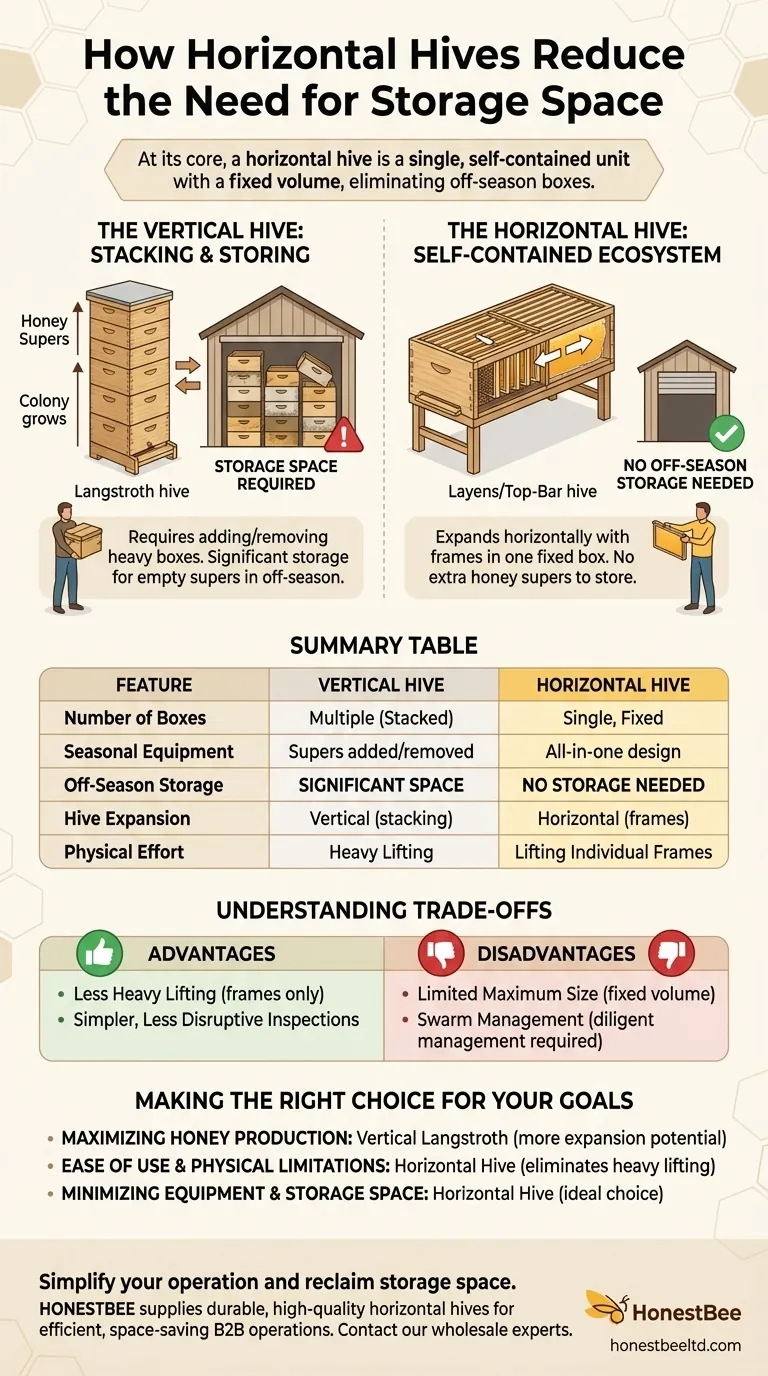At its core, a horizontal hive reduces the need for storage space because it is a single, self-contained unit. Unlike common vertical hives that require adding and removing heavy boxes (called "supers") as the colony expands or contracts, a horizontal hive's volume is fixed, meaning you never have off-season boxes that need to be stored.
The choice between a horizontal and vertical hive is a choice of management philosophy. Vertical hives are managed by adding or removing entire boxes, while horizontal hives are managed by rearranging frames within a single, long box.

The Vertical Hive: Stacking Boxes and Storing Extras
To understand why horizontal hives save space, we must first look at the design of the most common beehive, the vertical Langstroth hive.
How Vertical Hives Expand
A standard Langstroth hive starts with one or two deep boxes for the queen to lay eggs and the bees to raise brood. This is the core of the colony.
As the nectar flow begins and the colony grows, the beekeeper must add more boxes—called honey supers—on top. This gives the bees space to store surplus honey.
The Source of the Storage Problem
A strong colony in a good year might need three, four, or even more honey supers stacked on top of the brood boxes.
When the honey is harvested, or as the season ends and the colony shrinks for winter, these supers are removed. They must then be cleaned and stored in a garage, shed, or barn, protecting them from pests and weather until the next season. This is where the significant storage requirement originates.
The Horizontal Hive: A Self-Contained Ecosystem
Horizontal hives, such as the Layens or Top-Bar hive, operate on a completely different principle. They are essentially a single, long box laid on its side.
Managing Space with Frames, Not Boxes
The colony expands horizontally instead of vertically. The brood nest typically starts in the center or at one end. As the colony grows, the beekeeper adds empty frames next to the existing ones.
The bees build out the comb, and the queen expands the brood nest. Excess honey is stored on frames farther away from the brood area. All this activity happens within the same box.
Eliminating Off-Season Equipment
Because the hive is one single piece, there are no extra honey supers to add during the season or remove and store during the winter. The hive itself is the only piece of major equipment you need to house.
Understanding the Trade-offs
The single-box design offers simplicity, but it's important to understand the associated trade-offs.
Advantage: Less Heavy Lifting
The most celebrated benefit of horizontal hives is the elimination of heavy lifting. You never have to lift a 50-pound honey super. Management involves lifting one frame at a time, which weighs only a few pounds.
Advantage: Simpler, Less Disruptive Inspections
Inspections can be less disruptive to the colony. You can inspect one frame at a time without having to "unstack" the entire hive, which keeps more of the colony's heat and structure intact.
Disadvantage: Limited Maximum Size
The primary trade-off is that the hive's total volume is fixed. A vertical hive can be expanded almost infinitely by adding more boxes, allowing for massive honey crops in exceptional years. A horizontal hive has a finite limit, which can cap its peak honey production.
Disadvantage: Swarm Management
Because the space is finite, a rapidly growing colony can feel "crowded" sooner than in a vertical hive. This requires diligent management from the beekeeper to provide space and monitor for signs of swarming.
Making the Right Choice for Your Goals
Your choice of hive should align with your personal goals as a beekeeper.
- If your primary focus is maximizing honey production: A vertical Langstroth hive offers more potential for expansion and larger harvests.
- If your primary focus is ease of use and physical limitations: A horizontal hive is the clear winner, as it eliminates all heavy lifting.
- If your primary focus is minimizing equipment and storage space: A horizontal hive's single-box design makes it the ideal choice.
Ultimately, matching the hive system to your beekeeping philosophy is the key to long-term success and enjoyment.
Summary Table:
| Feature | Vertical Hive | Horizontal Hive |
|---|---|---|
| Number of Boxes | Multiple (Brood boxes + honey supers) | Single, fixed box |
| Seasonal Equipment | Honey supers added/removed seasonally | No extra boxes; all-in-one design |
| Off-Season Storage | Requires significant space for empty supers | No off-season storage needed |
| Hive Expansion | Vertical (stacking boxes) | Horizontal (adding frames within the box) |
| Physical Effort | Heavy lifting of full supers | Lifting individual frames only |
Simplify your beekeeping operation and reclaim your storage space. HONESTBEE supplies commercial apiaries and beekeeping equipment distributors with the durable, high-quality horizontal hives and equipment needed for a more efficient, space-saving operation. Contact our wholesale experts today to discuss how our solutions can benefit your business.
Visual Guide

Related Products
- Long Langstroth Style Horizontal Top Bar Hive for Wholesale
- HONESTBEE Professional Long Handled Hive Tool with Precision Cutting Blade
- HONESTBEE Advanced Ergonomic Stainless Steel Hive Tool for Beekeeping
- HONESTBEE Professional Multi-Functional Hive Tool with Ergonomic Wood Handle
- Multi-Function Plier-Style Frame Grip Hive Tool
People Also Ask
- How does the top bar hive help control varroa mites? A Natural Approach to Mite Management
- What are the most popular types of hives besides the Langstroth? Top Bar & Horizontal Hives Explained
- What are the benefits of the top bar hive? A Guide to Ergonomic, Natural Beekeeping
- What is a top bar bee hive? A Natural, Low-Stress Beekeeping Solution
- What are the box management requirements for a top bar hive vs. Langstroth? Choose Your Hive Strategy



















